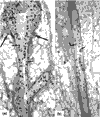Tumour-stromal interactions. Role of the stroma in mammary development
- PMID: 11434872
- PMCID: PMC138685
- DOI: 10.1186/bcr299
Tumour-stromal interactions. Role of the stroma in mammary development
Abstract
Mammary development depends on branching morphogenesis, namely the bifurcation and extension of ductal growth points (end buds) and secretory lobules into a more or less fatty stroma. Because breast carcinomas are overwhelmingly ductal in origin, this review focuses on stromal influences guiding postnatal ductal development and there is only the briefest account of the role of embryonic stroma (mesenchyme). The stroma as the necessary target for endocrine mammogens and the source of stimulatory growth factors is described and the importance of mammary epithelium-induced modifications of the periductal stroma is emphasized. Evidence is presented that if they are to grow, end buds must condition proximal fatty stroma by recruiting white blood cells as well as inducing stromal cell division and, possibly, estrogen receptors. The induction of a fibrous stromal tunic around the end bud is described and its likely role as a complex ductal morphogen is discussed; a possible role in growth inhibition is also considered. Although the signals governing fibrotic induction, ductal morphogenesis, and growth inhibition are unknown, a role for transforming growth factor-beta is highly likely and is discussed. Finally, a need for new conceptual and experimental approaches to understanding stromal-epithelial signaling is discussed.
Figures



References
-
- Streuli CH, Haslam SZ. Control of mammary gland development and neoplasia by stromal-epithelial interactions and extracellular matrix. J Mamm Gland Biol Neoplasia. 1998;3:107–108. This article introduces and reviews the contents of an eponymous issue of the Journal of Mammary Gland Biology and Neoplasia. As the title suggests, there are numerous interesting papers related to the subject of the present review.
-
- Hovey RC, McFadden TB, Akers RM. Regulation of mammary gland growth and morphogenesis by the mammary fat pad: a species comparison. J Mamm Gland Biol Neoplasia. 1999;4:53–68. - PubMed
-
- Sakakura T. New aspects of stroma-parenchyma relations in mammary gland differentiation. Int Rev Cytol. 1991;125:165–202. This review places the seminal experiments by the author as well as those of K Kratochwil and others in a modern context. - PubMed
-
- Chepko G, Smith GH. Mammary epithelial stem cells: our current understanding. J Mamm Gland Biol Neoplasia. 1999;4:35–52. - PubMed
-
- Daniel CW, Robinson S, Silberstein GB. The role of TGFβ in patterning and growth of the mammary ductal tree. J Mamm Gland Biol Neoplasia. 1996;1:331–341. - PubMed
Publication types
MeSH terms
Substances
LinkOut - more resources
Full Text Sources
Medical

